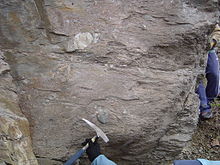- Marinoan glaciation
-
Neoproterozoic Snowball Periods-1000 —–-950 —–-900 —–-850 —–-800 —–-750 —–-700 —–-650 —–-600 —–-550 —A recent estimate of the timing and duration of Proterozoic glacial periods. Note that great uncertainty surrounds the dating of pre-Gaskiers glaciations. The status of the Kaigas is not clear; its dating is very tentative and many researchers do not recognise it as a glaciation.[1] An earlier and longer possible snowball phase, the Huronian glaciation, is not shown here.
The Marinoan glaciation was a period of worldwide glaciation that lasted from approximately 650 to 635 Ma (million years ago) during the Cryogenian period. The glaciation may have covered the entire planet, in an event called the Snowball Earth. The end of the glaciation may have been sped by the release of methane from equatorial permafrost.[2]
Contents
Cryogenian Snowball Earth
Emerging evidence suggests that the Earth underwent a number of glaciations during the Neoproterozoic era.[3] There were three (or possibly four) significant ice ages during the late Neoproterozoic. These periods of nearly complete glaciation of Earth are often referred to as "Snowball Earth", where it is hypothesized that at times the planet was covered by ice 1–2 km (0.62–1.2 mi) thick.[4] Of these glaciations, the Marinoan was the most significant, whereas the Sturtian glaciation was a shorter, but still worldwide glaciation. The Kaigas glaciation is considered the earliest of Cryogenian glaciations.[5] Other Cryogenian glaciations were probably small and not global as compared to the Marinoan or Sturtian glaciations.
During the Marinoan glaciation, characteristic glacial deposits indicate that Earth suffered the most severe ice ages in its history. Glaciers extended and contracted in a series of rhythmic pulses, possibly reaching as far as the equator.[6][7]
Evidence
Even though much evidence has been lost through geological changes, field investigations show evidence of the Marinoan glaciation in China, Svalbard archipelago and South Australia. In Guizhou Province, China, glacial rocks were found to be underlying and overlaying a layer of volcanic ashes which contained zircon minerals, which could be dated through radioisotopes. Glacial deposits in south Australia are approximately the same age (about 630 Ma), confirmed by similar stable carbon isotopes, mineral deposits (including sedimentary barite), and other unusual sedimentary structures.[4] Two diamictite-rich layers in the top 1 km (0.62 mi) of the 7 km (4.3 mi) Neoproterozoic strata of the northeastern Svalbard archipelago represent the first and final phases of the Marinoan glaciation.[8]
See also
- Sturtian glaciation
- Huronian glaciation
References
- ^ Smith, A.G. (2009). "Neoproterozoic timescales and stratigraphy". Geological Society, London, Special Publications (Geological Society, London, Special Publications) 326: 27–54. doi:10.1144/SP326.2.
- ^ Shields, G. A. (2008). "Palaeoclimate: Marinoan meltdown". Nature Geoscience 1 (6): 351–353. doi:10.1038/ngeo214.
- ^ Allen, Philip A.; Etienne, James L. (2008). "Sedimentary challenge to Snowball Earth". Nature Geoscience 1 (12): 817. doi:10.1038/ngeo355.
- ^ a b "New Evidence Supports Three Major Glaciation Events In The Distant Past". ScienceDaily. 2004-04-22. http://www.sciencedaily.com/releases/2004/04/040421234349.htm. Retrieved 2011-06-18.
- ^ Stern, R.J.; Avigad, D.; Miller, N.R.; Beyth, M. (2006). "Geological Society of Africa Presidential Review: Evidence for the Snowball Earth Hypothesis in the Arabian-Nubian Shield and the East African Orogen". Journal of African Earth Sciences 44: 1–20. doi:10.1016/j.jafrearsci.2005.10.003.
- ^ Dave Lawrence (2003). "Microfossil lineages support sloshy snowball Earth". Geotimes. http://www.agiweb.org/geotimes/apr03/WebExtra041803.html. Retrieved 2011-06-18.
- ^ "Global Glaciation Snowballed Into Giant Change in Carbon Cycle". ScienceDaily. 2010-05-02. http://www.sciencedaily.com/releases/2010/05/100501013533.htm. Retrieved 2011-06-18.
- ^ Halverson GP, Maloof AC, Hoffman PF (2004). "The Marinoan glaciation (Neoproterozoic) in northeast Svalbard" (pdf). Basin Research 16 (3): 297–324. doi:10.1111/j.1365-2117.2004.00234.x. http://geoweb.princeton.edu/people/maloof/downloads/marinoan.pdf. Retrieved 2011-06-18.
Greenhouse and Icehouse Earth Greenhouse Earth
(Tropical temperatures may reach poles)
Icehouse Earth
(Global climate when ice ages are possible)
Snowball Earth
(Earth's surface became nearly or entirely frozen over)
Warm period Interglacial Stadial (cooler period in an Interglacial, like the Little Ice Age) and Interstadials (warmer period within a Glacial) Glacial Cold period Categories:- Ice ages
- Glaciology
- Climate history
- Proterozoic
- Extinction events
- Climate change
- Historical geology
Wikimedia Foundation. 2010.

